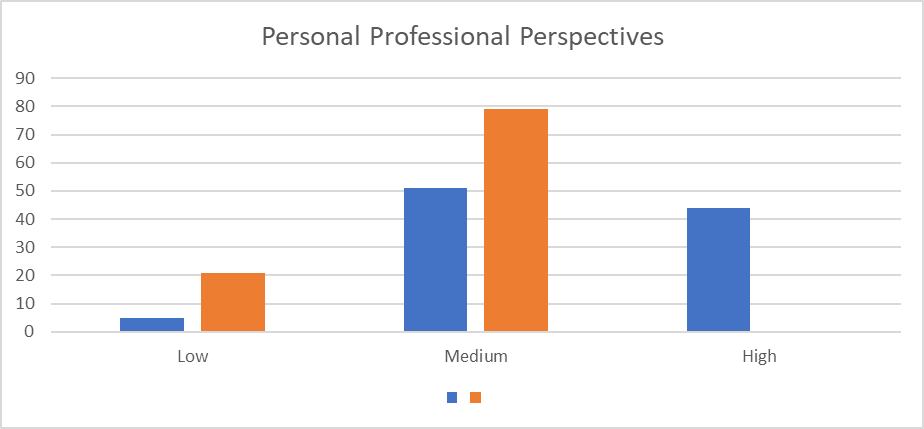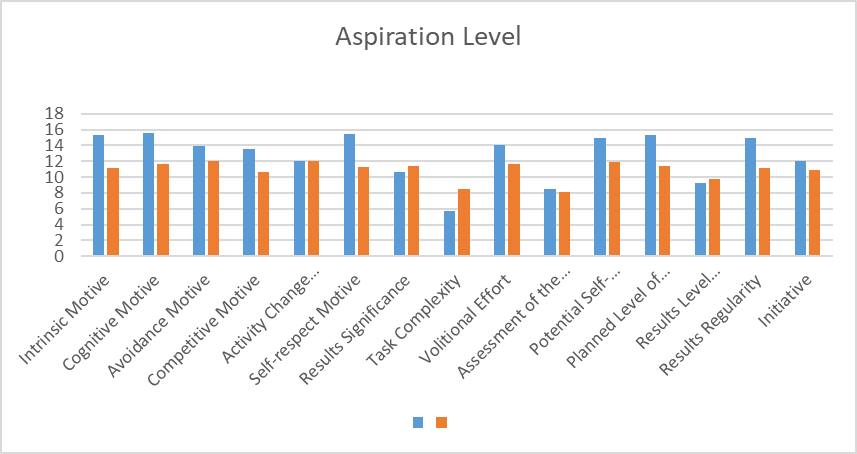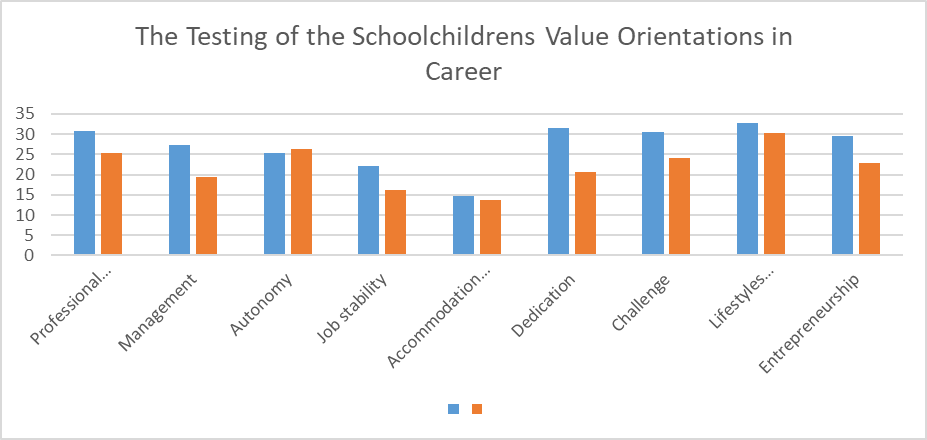Abstract
The relevance of the researched issue is determined by the fact that a professional identity is an important factor of social and psychological adaptation of teenagers and young men. Schoolchildren in Muslim migrants families may not be quite ready for professional self-determination, which can have a negative impact on their adaptation in general. In this regard, this article is aimed at studying the peculiarities of professional orientation of schoolchildren from families of Muslim migrants. The leading research method of the issue is testing, which allows to consider the process of the schoolchildren’s professional orientation forming. The article presents the results of the professional orientation study of schoolchildren from Muslim migrants families, which can be used for further research and professional self-determination development. The article can be useful for teachers and psychologists working on issues of social and psychological adaptation and professional orientation of migrants’ children.
Keywords: Professional identityprofessional orientationadaptationchildren of migrants
1. Introduction
Qualitative and quantitative changes in migration processes in Russia and around the world require analysis and deep reflection because they are not unambiguous. The term “adaptation” is used to understand the processes coming alongside with migration. Nowadays, together with the social, cultural and psychological adaptation, economic adaptation is also defined. It involves such factors as presence or absence of job, job satisfaction, level of professional achievement and well-being in the new culture (Berry et al., 1990). Successful adaptation of schoolchildren in migrant families is impossible without developed professional self-determination, conscious choice of profession, and desire to improve professional skills. Psychological and pedagogic studies of professional identity lay out two approaches. The first considers self-determination as a natural process that occurs at a certain stage of ontogenesis and exists as a personal formation in high school age. Professional identity is inextricably linked with an essential characteristic of adolescence - focus on future; identifying themselves as members of the society, and the need to solve problems of the future. The second approach views self-determination as an artificially organized process that is embedded in specific vocational guidance, and only in this sense does it acquire its meaning and value. The process of professional self-determination is especially relevant for students aged 12 to 18. (Klimov, 2004. But many students face several challenges during the process of professional self-determination. As noted by psychologists and educators, these challenges can often include; the inadequate understanding of the professions and the labour market, weak knowledge of their personal abilities and possibilities, focus on external attributes of a profession (romanticizing the profession) or preferring jobs that are seen as prestigious and profitable in the society. Students in migrant families have more difficulties in navigating in the world of professions, especially if the cultural differences between the cultures of the mother country and the settlement country are large enough.
Research methods
The process of research involved the following methods: theory (analysis; synthesis; summarizing; modeling); testing with the use of the following methods: Personal and Professional Perspective (Pryazhnikov, 1996), Level of Aspiration (Batarshev, 2005), Career Anchors (Schein, 1992) modified by (Chiker, 2006); experimental (summative); and methods of mathematical statistics and graphical display of results.
The experimental base of the research
The pilot survey was conducted at the Municipal budgetary general education institution "Secondary Russian-Tatar school № 111".
The stages of the research
The study of the problem was carried out in two stages:The first stage involved theoretical analysis of existing methodological approaches in psychological and pedagogical scientific literature and the thesis on the issue; the problem, the purpose, and the methods of the research were highlighted, and the plan of experimental research was drawn.
At the second stage, methods were designated that allow to adequately determine the features of professional orientation development of schoolchildren, the complex of pedagogical conditions of effective professional self-determination was identified and substantiated; summative experiment was conducted, and the findings of experimental work were analyzed.
Findings
The study involved schoolchildren of 9-11 grades, 34 of them were included in the control group, 12 (8 boys and 4 girls) schoolchildren were from Muslim migrants families hailing from CIS countries (Uzbekistan, Kyrgyzstan, Kazakhstan, Tajikistan). The features of professional orientation were studied with the help of techniques for determining value orientations, motivation and specifics of professional choice planning, as well as the appropriate test methods.
Diagnostics of personal professional perspective of schoolchildren
A study of personal professional perspective of schoolchildren was carried out with the use of the personal professional perspective technique (LPP) by Pryazhnikov (1996). The results of the study are presented in Figure
This technique allows us to consider the personal professional perspective of schoolchildren in levels: high, medium and low.

The distribution data shows that a high level of personal and professional perspectives (44%) is mainly apparent among the schoolchildren of the control group. Such children are usually aware of the need for professional education, the availability of short-and long-term goals for the future and ways to achieve them. They are able to orientate themselves in the professional sphere and have an idea of their advantages and disadvantages.The medium level of personal and professional perspectives is typical for schoolchildren from Muslim migrants families (79%); at the same time it makes 51% in the control group. Children know their plans, future goals, ways to achieve them, and have some ideas about their professional future.
21% of schoolchildren from Muslim migrant families and 5% of schoolchildren in the control group represent the low level. These children have rather elusive plans and goals for the future, orientate poorly in the professional world and have nebulous ideas about themselves, their strengths and weaknesses, and poorly know ways of overcoming their setbacks.
Thus, we can conclude that the schoolchildren in the control group have an idea of further professional perspective. They have and make professional plans and goals for the nearest and the furthest future, have an idea of who they are, while the schoolchildren from families of migrant Muslims have challenged awareness of internal and external obstacles in concerns of goal achievement, as well as having a reserved option.
The study of the motivational structure of schoolchildren’s professional orientation
To identify the components of the schoolchildren’s motivational structure, we used the psycho-diagnostic technique of the aspiration level determination (Batarshev, 2005). The distribution data is presented on the chart (Figure
Schoolchildren from Muslim migrants families show higher scores on the following indicators: Task Complexity, Results Significance and Results Level Expectations. Accordingly, students in this group are result-oriented and concerned about other people evaluating their effectiveness in the activities; they are focused on complex tasks.

All together, they are characterized with the lower assessment of their potential, confidence in their goals and interest in the completion of assignments.
However, schoolchildren from Muslim migrants families are characterized by the desire to achieve their goals, but they are not confident in their abilities and require a positive evaluation of their activities.
The testing of the schoolchildren’s value orientations in their careers
The value orientations testing of high school children in concerns of career were carried out with the help of the testing methods "Career Anchors" by Schein (1992) modified by Chiker (2006). Career orientations emerge in early years of career development, they are resistant and can remain stable for a long time. Very often a person realizes his/her career orientations unconsciously. The results are presented in Figure

The graph shows that the two groups of respondents perform in different ways. The schoolchildren in the control group have such value orientations in a career as Integration of Lifestyles, Dedication, Challenge, Entrepreneurship, Professional Competence. All the aforementioned value orientations are associated with their possibilities and abilities in professional activities. In particular, the "Integration of Lifestyles" means the commitment of a person to combine and balance professional and personal spheres. "Dedication" incorporates the orientation to implement their personal career values; such people want to dedicate themselves to the society and to be useful for the others. "Challenge" involves people characterized with the ability to solve notoriously complex problems, the ability to resolve insurmountable problems for the sake of victory in a competition. Value orientation "Entrepreneurship" stems from the fact that these people like to create something new that will relate to their efforts. Working for other people is not their goal; their career aims at implementing ideas that entirely belongs to them. "Professional Competence" is associated with the presence of skills and talents in a particular activity. People with this orientation want to know their business; they are especially happy when they succeed in the professional sphere; nevertheless, they quickly lose interest for any work that isn’t able to develop their abilities.
Schoolchildren from Muslim migrants families show such value orientations as Professional Competence, Autonomy, Integration of Lifestyles. "Autonomy" is associated with exemption from organizational rules, regulations and restrictions. They experience difficulties connected with the established rules, procedures, working hours, discipline, uniforms etc. For them, the primary task of career development is the possibility to work independently, to decide how, when, and what should be done for the achievement of a certain goal. Career for them is, first of all, the way to actualize their freedom, so any framework and strict obedience can deter them from a seemingly attractive job.Thus, we can say that both groups of respondents chose values, in which their potential and abilities can be fully realized. They are committed to balancing professional and personal spheres, and they value stability.
The analysis of psychological and pedagogical literature allows to consider the process of professional self-determination as an influence on the further course of human life and not just for its professional component, but also on the prospects of family creation, material status, inner harmony, self-esteem and relationship with the self, in one word, on the entire way of life. Professional self-determination is the most important stage of socialization. According to most researchers, professional determination involves professional orientation and professional identity. Professional orientation is one of the indicators of personal development.
S. N. Chistyakova defines the structure of professional orientation of a personality as a complex of motives, preferences, professional interests, aptitudes, abilities, professional identity that defines personal meaning of the future professional activity, confidence in the choice of profession suitability (Chistyakova, 2004). Thus, in order to define the peculiarities of professional self-determination of schoolchildren from Muslim migrants families, it is necessary to study the components of professional orientation (interests, aptitudes, motives of career choice, value orientation) and professional identity. Formed professional self-determination can be considered as one of the indicators of social and economic adaptation of schoolchildren from Muslim migrants families.
Conclusion
The research has allowed to establish that schoolchildren from Muslim migrants families are characterized by low and average level of professional orientation formation, so it is important to organize professional education for schoolchildren: to inform them about professions, the prospects of getting a profession, and the economic demand of professions in the region. Value orientations of schoolchildren from Muslim migrants families express the need for autonomy and the possibility to combine professional and private (family) life. During professional counseling, it is necessary to pay attention to the assessment of the aspiration level of schoolchildren from Muslim migrants families, because, unlike students in the control group, they typically have greater demands on their performance and less confidence in their abilities.
The results of the experiment allowed us to create a model of professional self-determination development among schoolchildren and also an art therapy vocational training program. The article can be useful for school psychologists in vocational guidance work with high school students, as well as for teachers and psychologists working with schoolchildren from Muslim migrants families.
The next step of the study is the analysis and comparison of the result of art therapy vocational training for schoolchildren from Muslim migrants families.
Acknowledgements
The work is performed according to the Russian Government Program of Competitive Growth of Kazan Federal University.
References
- Batarshev, A. V. (2005). Basic psychological properties and professional self-determination of a person. Saint Petersburg: Rech. 208.
- Berry, J.W., Poortinga, Y.N., Segall, M.N. & Dasen, P.R. (1990). Cross-cultural psychology: research and application. NY.
- Chiker, V. A. (2006). Psychological diagnostics of organization and personnel. Saint Petersburg: Rech’.
- Chistyakova, S.N. (2004). Pedagogical Support of Professional Self-determination of Schoolchildren. Moscow: Akademiya.
- Klimov, E. A. (2004). Psychology of Professional Self-determination. Moscow: Akademiya.
- Pryazhnikov, N. S. (1996). Professional and Personal Self-determination. Moscow: Institut prakticheskoy psikhologii. Voronezh: NPO MODEK.
- Schein, E. (1992). Organizational Culture and Leadership. San Francisco.
Copyright information

This work is licensed under a Creative Commons Attribution-NonCommercial-NoDerivatives 4.0 International License.
About this article
Publication Date
31 August 2017
Article Doi
eBook ISBN
978-1-80296-028-0
Publisher
Future Academy
Volume
29
Print ISBN (optional)
-
Edition Number
1st Edition
Pages
1-960
Subjects
Teacher, teacher training, teaching skills, teaching techniques
Cite this article as:
Guryanova, O. A. (2017). Professional Orientation Features Of Schoolchildren In Muslim Migrants Families. In R. Valeeva (Ed.), Teacher Education - IFTE 2017, vol 29. European Proceedings of Social and Behavioural Sciences (pp. 275-281). Future Academy. https://doi.org/10.15405/epsbs.2017.08.02.33

